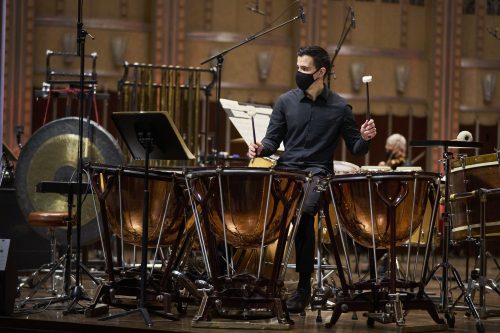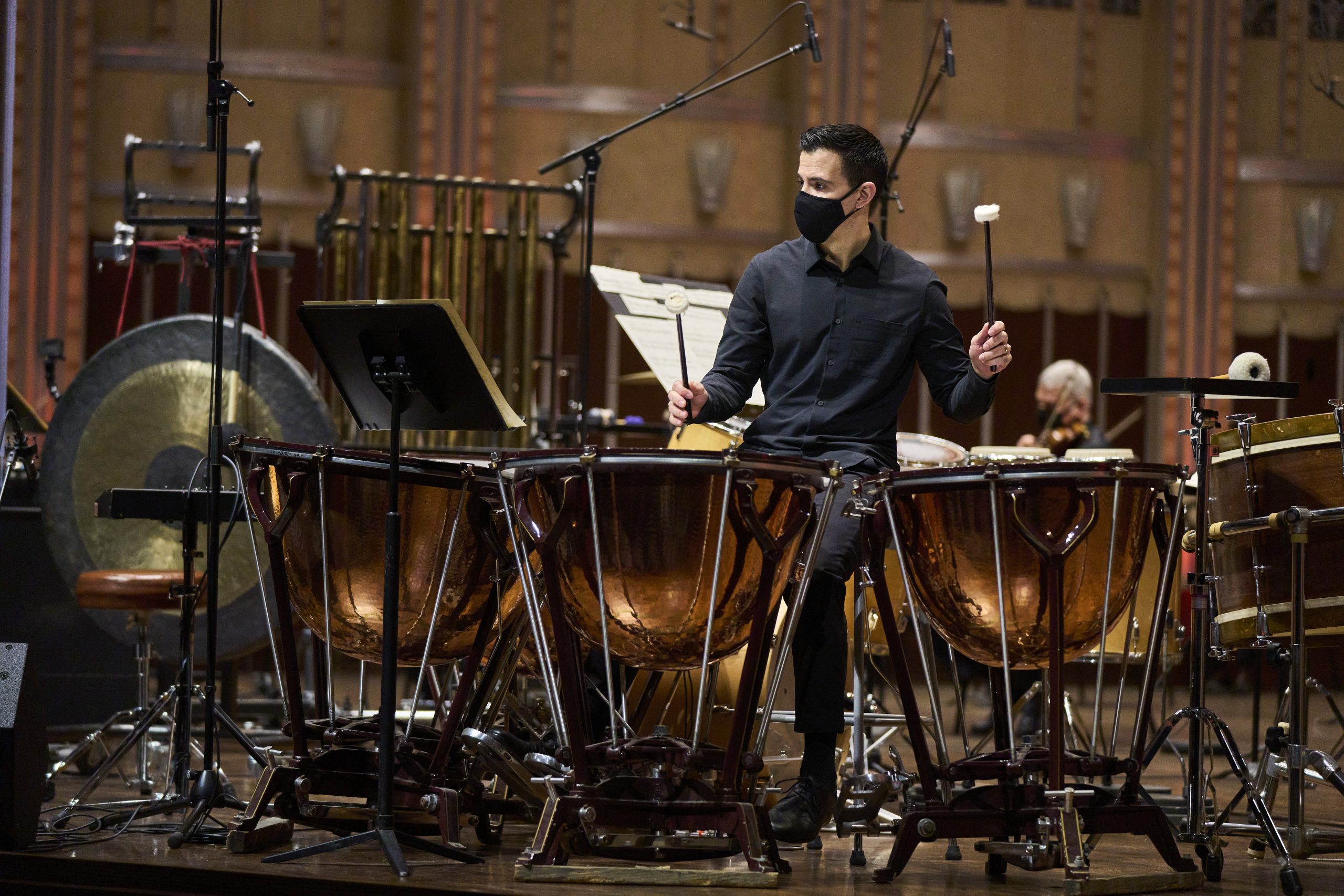 United States In Focus/Episode Nine, Magical Musicians: Marc Damoulakis (percussion), Strings of the Cleveland Orchestra / Franz Welser-Möst (conductor). Filmed at Severance Hall, Cleveland, on 25-27.3.2021, and reviewed as a video stream. (MSJ)
United States In Focus/Episode Nine, Magical Musicians: Marc Damoulakis (percussion), Strings of the Cleveland Orchestra / Franz Welser-Möst (conductor). Filmed at Severance Hall, Cleveland, on 25-27.3.2021, and reviewed as a video stream. (MSJ)

Dvořák – String Quintet No.2 in G major Op.77
Corigliano – Conjurer: Concerto for Percussionist
‘I think contemporary music has many people now that are really reaching out to their audiences, because we lost them a long time ago. We’re getting them back now. And new music is getting to be more and more important’. So speaks composer John Corigliano of his percussion concerto, Conjurer, in one of the bonus videos attached to this streamed performance, and he should know. He is a proven master of music that is engaging and moving yet challenging, without being so abstruse that it alienates. A composer with numerous impressive scores under his belt, including two symphonies and several concertos, Corigliano finds a wide range of expression in his music. Any concerto by him is bound to be virtuosic, and this one certainly is.
It’s also far more than a showpiece. Epic and intense, it rewrites the nature of a percussion concerto, avoiding the insubstantial decorative style of most such compositions. Instead, Corigliano selects a wide range of percussion instruments but then groups them for each movement. The first movement is all wooden instruments, metal instruments are used in the second, and the finale is all ‘skins’, which is to say drums of various sorts.
But Corigliano’s big innovation – and it is one that helps focus a concerto for diverse instruments like this – is to have a cadenza start each movement. The focus is placed squarely on the soloist to establish melodic material, which is taken up by the string orchestra as it eventually joins in. Since these cadenzas create the material of the concerto, they inspired the title, for it puts the soloist in the apparent role of conjurer.
The intensity of the work, though, isn’t just a magic show: it is more akin to something shamanistic. The first movement is the most conventional, with dizzying runs on the xylophone and marimba, but it is more than that, thanks to Corigliano’s ability to reinvent. In addition to the pitched instruments, there is a set of unpitched wooden percussion instruments also arranged from low to high, so that they can be played in the same melodic manner as the pitched instruments. This allows Corigliano to start with somewhat conventional passagework but turn it into something that surprises the listener. He continually ups the ante, taking turns that add tension. After a reprieve, the movement races to its close on melodic fragments in the strings, only to be interrupted by the stern roar of chimes and gong at maximum volume, beginning the second movement cadenza without pause.
The metal instrument group includes the vibraphone which, like the chimes, can sustain notes long enough for the composer to unfurl poignant melody bound by rich chords. The emotion builds to another roar from the gong and chimes, this time followed by a visionary passage with a combination of vibraphone notes struck with the mallet, with the player immediately thereafter bowing the side of each plate with a string instrument bow, creating an otherworldly lyricism of heartbreaking vulnerability. This conjurer casts spells.
Just as the music seems on the verge of disappearing into itself, it quietly shifts into the third cadenza, with the percussionist playing slow beats on a talking drum with a few quiet punches from a kick drum. This gradually blooms into a joyfully frenetic drumming that includes drum sets, various sizes of bass drum, timpani (played by hand at first) and more. The later pages of the concerto see the soloist set free in improvisation as the strings rocket toward a frenetic close, offering no release of the built-up tension until the visceral ending. The work is exhilarating, and it raises the bar for all future percussion concertos.
Marc Damoulakis, the Cleveland Orchestra’s principal percussionist, was the conjurer on this occasion, and he fully fired up the pyrotechnics, savoring the many inward moments but rattling the roof in the climaxes. The fine sound of this concert stream allows the listener to hear the loud strokes cut into the distant corners of the hall, resonating in a way that Severance Hall doesn’t always offer. The level of the recording is also ideal: real heft is carried at a moderate volume, but the listener can liven it up by cranking up the volume and playing it loud, which I recommend. Damoulakis was fearless in inhabiting Corigliano’s bewitching world, and Franz Welser-Möst and the strings of the orchestra were eager allies in this unqualified triumph. Let’s hope this composition returns for regular visits, along with more of Corigliano’s work in general.
The Dvořák was new to me. I have been slowly exploring the treasures – and they are treasures – of the Czech master’s chamber music in recent years, but had not yet listened to this one. I can’t comment on how well it transfers to full string orchestra format, but I can testify to the winning warmth. Young Dvořák is not to be underestimated, and this is a youthful piece, earning its advanced opus number only from delayed publication. But as exploration of Dvořák’s early symphonies shows, he was a tremendously engaging composer long before fame claimed him.
Influenced by Dvořák’s predecessors such as Beethoven, Schubert and Schumann, this quintet also owes something to his older contemporary, Johannes Brahms. But while Dvořák shares a warmth similar to Brahms’s, he has a more wide-eyed sense of fun and adventure, and this performance explores that range. I suspect that the intricate interplay in the first movement is somewhat blurred by expansion to string orchestra dimensions, but the string writing is so idiomatic, and the players sound completely at home in the idiom.
The slow movement, in particular, sings sweetly with a tinge of melancholy, in contrast with the lively finale which builds up tremendous kinetic energy. Dvořák remains a seemingly inexhaustible font of melody, and the players sound like they are having a grand time with it. Welser-Möst, the orchestra’s music director, demonstrated last year that he was a persuasive advocate for early Dvořák with a delightful performance of the Fourth Symphony (click here) and he again finds the life-pulse of the music here.
Mark Sebastian Jordan
Subscriptions to the Cleveland Orchestra’s Adella streaming app are available at Adella.Live or on their website: click here.
